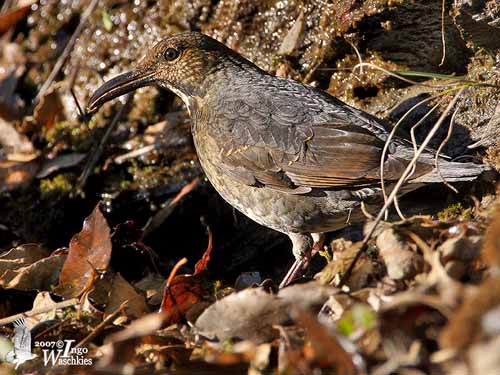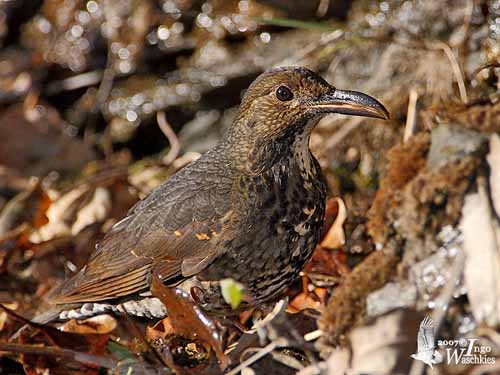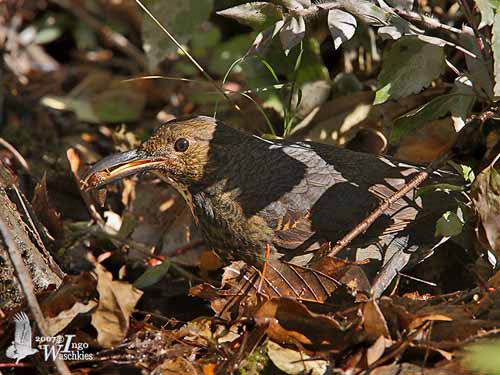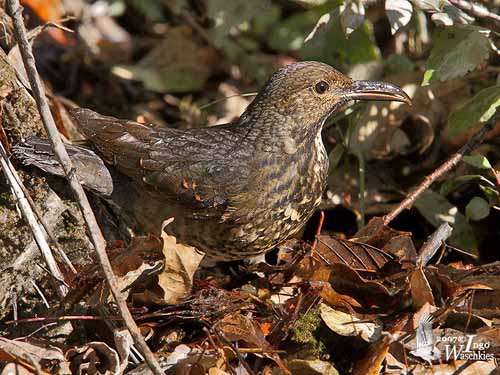
Fr: Grive montagnarde
All : Bergdrossel
Esp: Zorzal Picudo Grande
Ital: Tordo beccolungo maggiore
Nd: Grote Langsnavellijster
Sd: Långnäbbad trast
Photographer:
Ingo Waschkies
Bird Photography
Texte de Nicole Bouglouan
Sources:
HANDBOOK OF THE BIRDS OF THE WORLD Vol 10 by Josep del Hoyo-Andrew Elliott-David Christie - Lynx Edicions - ISBN: 8487334725
THRUSHES by Peter Clement and Ren Hathway – HELM - ISBN: 0713639407
A Field Guide to the Birds of South-East Asia by Craig Robson. New Holland Publishers. ISBN: 9781780090498
BirdLife International (BirdLife International)
Long-billed Thrush
Zoothera monticola
Passeriforme Order – Turdidae Family
BIOMETRICS:
Length: 26-28 cm
Weight: 115-130 gr
DESCRIPTION:
The Long-billed Thrush is very distinctive with its long, massive bill and its cryptic plumage melting into the background.
The adult has dark olive-brown plumage overall. On the upperparts, we can see an indistinct, narrow, blackish scaled effect. The wings are brown.
On the underparts, chin and throat are buffy-white. Breast and flanks are dull grey-brown, and the breast shows dark brown markings and some whitish feathers.
This pattern becomes less distinct on the dull buff upper flanks and sides of belly. Belly and vent are whitish with grey-brown markings.
On the brown head, crown and head sides are flecked pale buff, and we can see a dark malar stripe.
The stout, massive bill is very long, dark brown to blackish, and slightly hooked. The eyes are brown. Legs and feet are flesh-coloured.

Both sexes are similar.
The immature is darker brown with narrow, orangey streaks above, spotted wingbars and more spotted underparts.
We can find two subspecies:
Z.m. monticola is found in the Himalayas, E to Assam and NW Myanmar.
Z.m. atrata occurs in NC Vietnam. This one is darker overall.
VOICE: SOUNDS BY XENO-CANTO
The Long-billed Thrush is usually silent in winter, but we can hear sometimes its loud alarm call “zaaaaaa”
The song is given at dusk and dawn during short periods. This is a loud, mournful series of slow, sweet, clear whistles “te-e-uw” or “tsuweet-tsew-tsuw” with soft and lower last note.
This song may be introduced by harsher, rasping notes “rrraee ti tuu, trrray tya tyee…”
HABITAT:
The Long-billed Thrush breeds in undergrowth of evergreen shady forests (fir, bamboo and rhododendron) and in broadleaf evergreen forests.
This species favours wet areas with moist earth, muddy areas, soft banks and thick moss along water.
It can be seen between 2200 and 3800 metres of elevation in the Himalayas, but it performs some altitudinal movements to winter at lower elevation, between 1000 and 2500 metres.

RANGE:
See above in “subspecies”
BEHAVIOUR:
The Long-billed Thrush feeds mainly on invertebrates. It forages in the damp leaf litter and in muddy areas. It probes into the mud and trowels the substrate with the long, stout bill. While foraging, the bird often flicks the wings and appears very active.
Often seen alone, this thrush is well camouflaged in such habitat, thanks to the brown cryptic plumage.
The Long-billed Thrush is usually sedentary, only performing altitudinal movements in winter. Some short local movements may occur too.

FLIGHT:
The Long-billed Thrush has fast flight, often performed in cleared habitats or along streams. But this species usually prefers to hop quietly under cover into the dense vegetation. This is a very shy bird.
REPRODUCTION:
The breeding season occurs between May and July.
The nest is a large deep cup made with earth, dry leaves and damp green moss, and lined with fine fibres, rootlets, small twigs and lichens.
Such nest can be bulky. It is placed in tree fork or on branch, between 2 and 7 metres above the ground.
The female lays 3-4 pale green to grey-green eggs, or pale cream to warm buff with reddish-brown markings.
There is no more available information.

DIET:
The Long-billed Thrush feeds primarily on invertebrates found in the damp substrate of the forest floor. It takes mainly insects and their larvae, some snails, worms and molluscs. Some fruits are occasionally taken too.
PROTECTION / THREATS / STATUS:
The Long-billed Thrush is rare and local, and was previously considered Near Threatened, but currently, this species is evaluated as Least Concern by Birdlife International.
